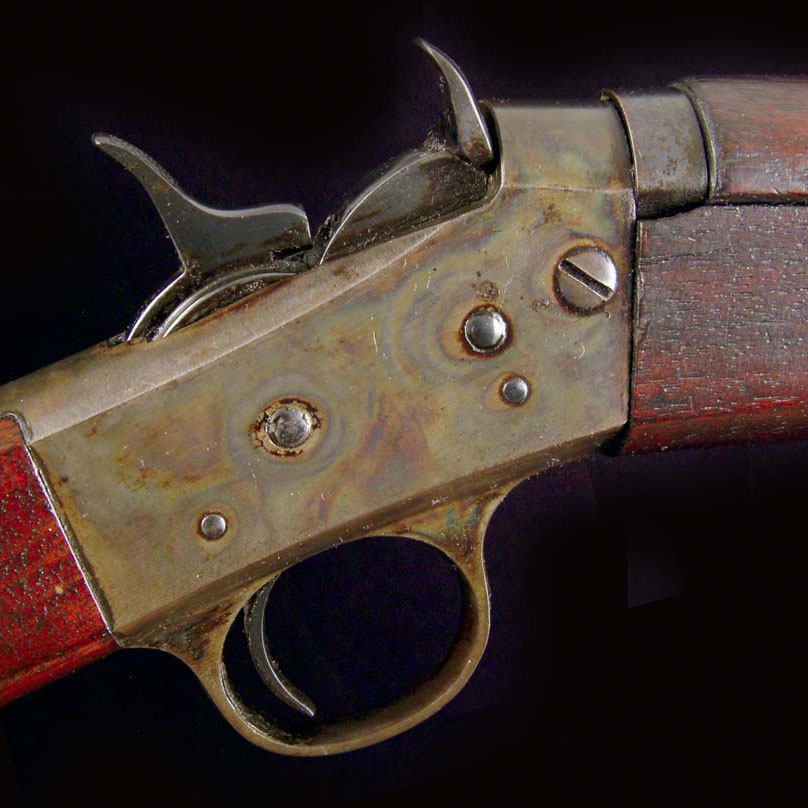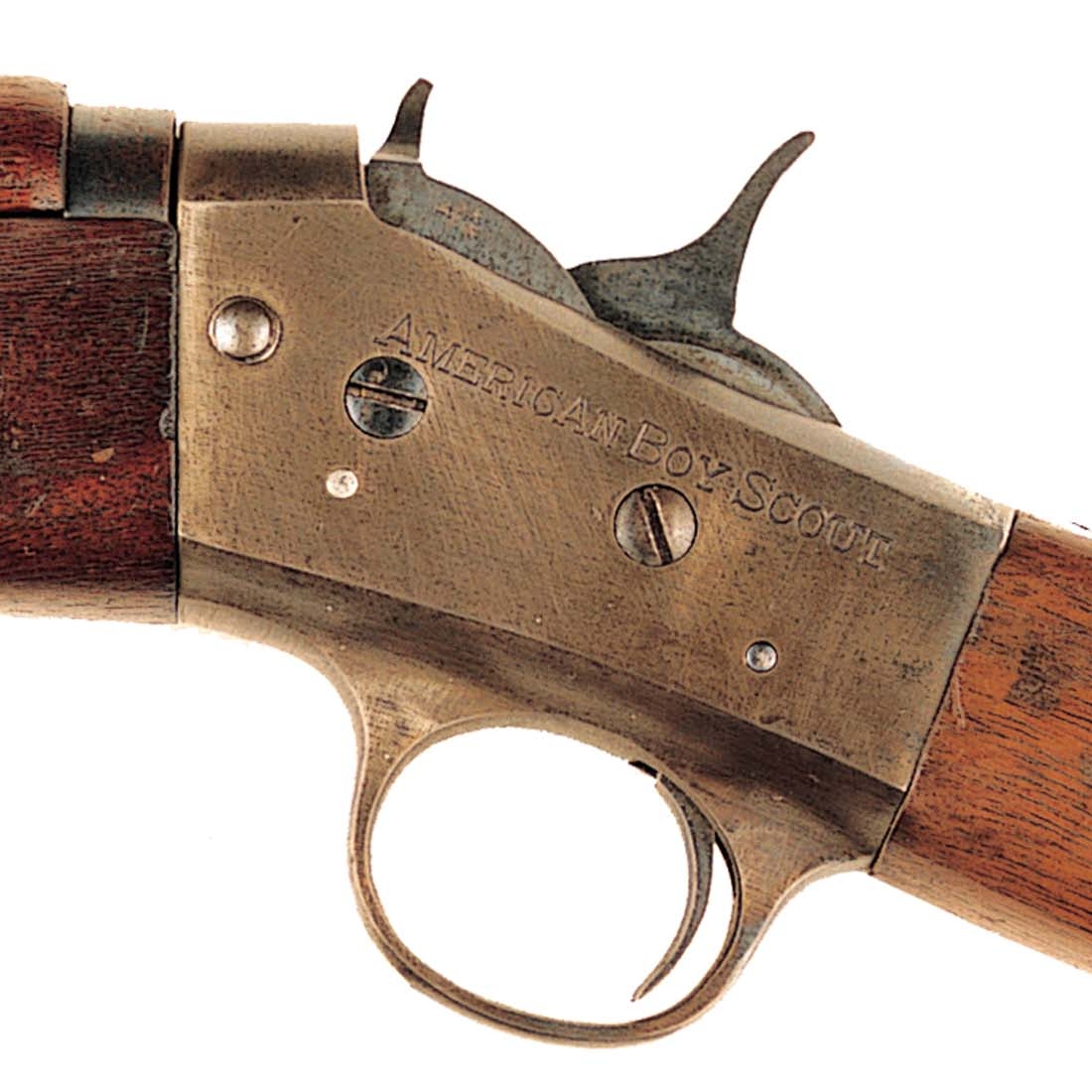
In 1913, Remington introduced a revised version of the Cadet rifle, calling it the No.4-S Boy Scout rifle. Early production examples were stamped AMERICAN BOY SCOUT on the left side of the receiver. Some modern-day references indicate that the words “Boy Scout” were stamped on early No.4-S rifles and that some rifles were unmarked, but only guns marked AMERICAN BOY SCOUT have been found.
In 1913 there were three major rival scout organizations: The Boy Scouts of America, The Boy Scouts of the United States, and The American Boy Scout. This latter organization renewed an earlier request for a military-style, single-shot rifle suitable for their boys. This request was formally sent to Remington Arms-Union Metallic Cartridge Company, the Winchester Repeating Arms Company, Ridabeck & Co., and to J.C. Stevens Arms & Tool Company.
On July 1, 1913, the American Boy Scout firearms selection committee recommended adoption of the Remington No.4S Boy Scout rifle as their official arm:










“We unhesitatingly recommend the arm submitted by the Remington Arms-UMC Co. To be adopted as the official rifle of the American Boy Scouts with the following changes: the barrel to be screwed into the frame instead of take-down (as submitted); and a new rear sight to be constructed with elevating cross bar.”
The American Boy Scout organization adopted the No.4-S Boy Scout rifle as their official arm. However, because of pressure from anti-violence influential donors, the Boy Scouts of America did not adopt any rifle. Ironically, the 1913 BSA Manual (on page 36) provided detailed information on a Marksmanship Badge that could be earned by the scouts.
The initial sales of Remington No.4-S Boy Scout rifles were funneled through the American Boy Scout organization. Remington’s stated goal (in the Minutes of the 3rd convention held January 6-11, 1913) was to get out a rifle for the boys who didn’t have enough money to buy an expensive rifle, and whom we wanted to have a Remington rifle in his hands. Only members of the American Boy Scouts could buy the rifle. Remington omitted the jobber and dealer and was able to sell the new rifle with bayonet directly to scouts for only $5. However, within a few months normal distribution channels were opened and the No.4-S Boy Scout rifle was sold to the general public for $8. (1913-14 Remington-UMC catalog).








The catalog also stated:
“The new Remington-UMC Boy Scout and Cadet Rifle is designed to meet the demand for an attractive and durable .22 cal. military arm of light weight for the younger generation. Its extreme accuracy and splendid handling qualities recommend it particularly for drill and target work. These features have caused it to be adopted by a number of the leading military academies throughout the country.”
A copy of a letter from the American Boy Scout organization dated July 1, 1912 verifies that the rifle submitted for testing from Remington-UMC was recommended as the authorized arm of the American Boy Scout. It was called unquestionably the strongest constructed arm submitted. Other guns, made by Stevens Arms and Tool Co., Winchester Repeating Arms Co. and Ridabock & Co. were also tested, but Remington received the order.
Characteristics of the No.4-S Boy Scout rifle include:
- 28 inch round barrel fitted with a removable bayonet lug.
- One-piece bayonet with leather scabbard that was originally furnished with the rifle.
- Oil finished, American Walnut stock (identical to that on No.4 sporting rifles) and a 23¼ inch military-style, tapered wood forearm, a 13½ inch handguard, two barrel bands, and a stacking swivel.
- Unique, small, military-type rear sight with ladder adjustment rear sight was that was not used on any other Remington firearm.
- Simple square metal blade front sight, dovetailed into the barrel.
- Case hardened receiver with the remainder of the metal parts (barrel, breech block, hammer, butt plate, barrel bands, etc.) blued.
- Advertised throughout its production as a solid frame, but it was not. The take-down frames from the lever system were used. A take-down screw (flush with the receiver (not a thumb screw) was on the right side of the receiver with left hand threads. The left hand threads were the cause of many angry words and mangled screw heads.








Most No.4-S Boy Scout Rifles do not have serial numbers. However, on those that do, the serial numbers are stamped on the bottom of the barrel in front of the receiver. The forearm needs to be removed to see the serial number. All serial numbers examined are under 5000. Some of these rifles have been found with numbers stamped prominently on the butt stock. These are ID numbers from academies, scout groups or other organizations, not from the Remington factory.








During its short production, the No.4-S Boy Scout rifle had at least three different barrel stamps:
- The earliest rifles retained the barrel stamping and location found on the predecessor No.4 Cadet rifle. All barrel markings were hidden by the forearm.
- The next type of barrel stamp was moved forward so they could be seen without removing the handguard.
- The third type, which includes the majority of production examples known added MODEL 4-S ahead of the other stamps.
The Remington “Boy Scout Model” was replaced by the Remington Military Model rifle in 1914. 















Click on any image: For a Full Size Original Image View or for Download Click the For In Browser View (with previous/next images):











































